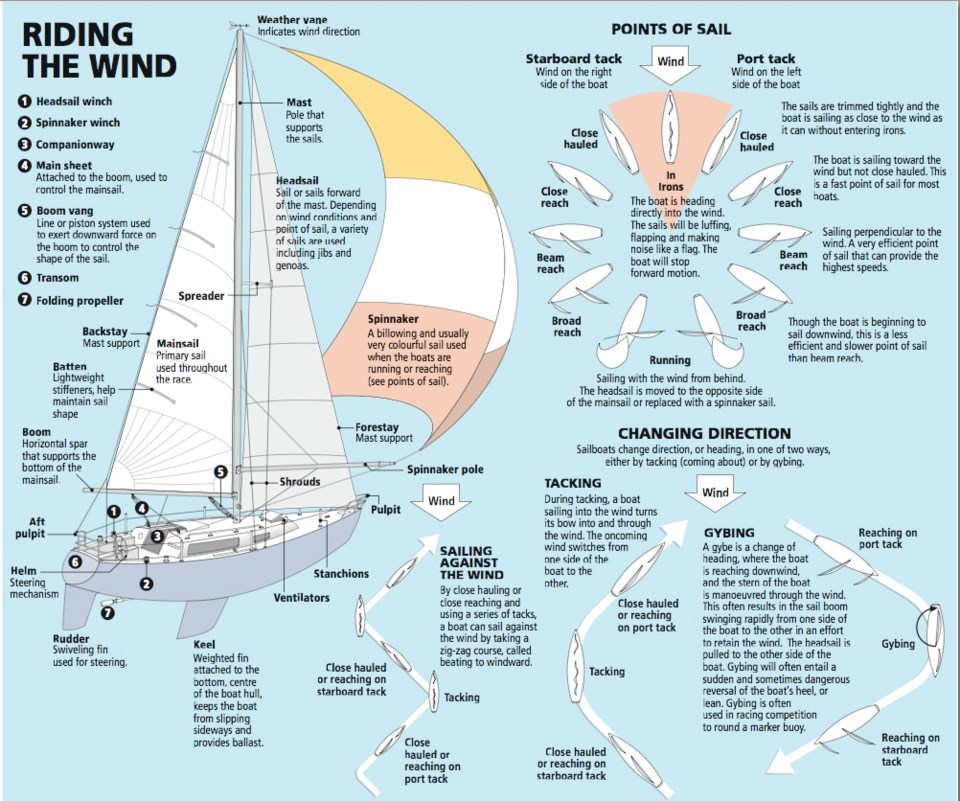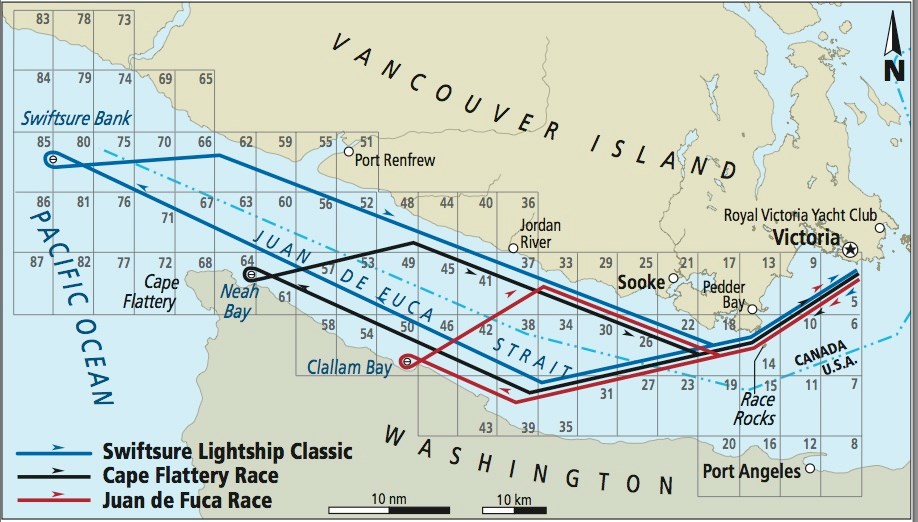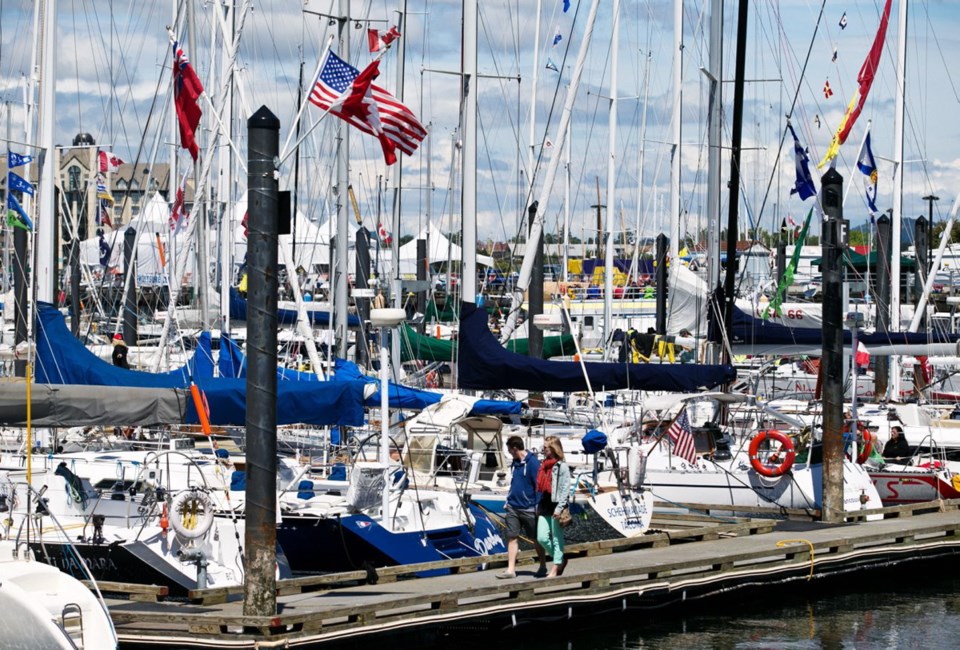Swiftsure chairman Vern Burkhardt was hooked the moment he sailed for the first time almost 30 years ago.
“It’s magical being on the water and using the wind as your method of propulsion,” he said this week. “The sound of the boat going through the water is very peaceful and also invigorating.”
Burkhardt spoke on the phone from the Seabee II, his C&C 38 vessel, which he was sailing from Sidney toward Victoria’s Inner Harbour to prepare for the 70th running of the Swiftsure International Yacht Race. The regatta is the longest-running cross-border race on the West Coast and challenges participants’ sailing skills, endurance, strategy and luck.
Organizers are hoping for a record turnout from both experienced amateurs and professional racers.
It began as an “audacious weekend challenge,” between the Seattle, Vancouver and Victoria yacht clubs in 1930, and now attracts visitors from California, Hawaii and beyond.
This will be Burkhardt’s third year as chairman of the event. He said that beyond watching the 194 boats jockey at the start line (divided between several races), spectators can look forward to walking the docks, checking out specialty boats, greeting a Jack Sparrow impersonator, grabbing some food or taking in dancing and music at Ship Point.
“There’s going to be lots of activities in the Inner Harbour,” said Burkhardt, who answered a few more questions about the race.
What is the Swiftsure International Yacht Race?
The longest-running cross-border race on the West Coast, for sailboats of all types and sizes. “For sailors, Swiftsure is a must-do race,” says Burkhardt. But it’s also a festive community event.
How was it started?
The first recorded sailboat racing in the Victoria area was in the late 1850s, between boats of the Royal Navy and the early colonists.
The Swiftsure regatta has its roots in an “audacious” weekend challenge between three yacht clubs in 1930 (Seattle, Vancouver and Victoria).
Where are the best places to watch? And when?
Clover Point on Saturday morning. Early-birds can come for a pancake breakfast at 8 a.m. The first of five races starts at 9 a.m., with the warning signal at 8:50 a.m. (each start is 10 minutes apart). After the final start, members of the Royal Canadian Air Force will demo a search and rescue. The start will also be livestreamed at 2013.swiftsure.org.
There will be good photo ops anywhere between Clover Point and Ogden Point.
What should people watch for?
Strange jockeying at the start. Because all the boats are already moving and no one can cross the start line ahead of the start, the challenging jockeying for position when the gun goes off is fascinating and may involve some collisions.
How can spectators follow along?
Two experienced racers will give a play-by-play commentary, broadcast live on speakers at Clover Point. You can also follow progress online at Swiftsure.org. Also online will be a live feed capturing racers after they cross the finish line, as well as shots taken by photographers from the water.
How much are those boats worth?
They range in value from a couple thousand dollars to a couple million. It truly is a “people’s race.” You don’t have to be rich to race a sailboat.
Where do they come from?
Sailboats come from all over the Pacific Northwest. Swiftsure has also drawn boats and sailors from California, Hawaii, New Zealand and even Russia. Crew members come from all over the world.
How many crew for each one?
The size of the crew varies from single-handed to more than 30. On average, there are about eight crew per boat.
How long will each of the races last?
The shortest race (Swiftsure Inshore Classic) will be over in time for a barbecue, awards ceremony and party at the Royal Victoria Yacht Club in Cadboro Bay. The Swiftsure Lightship Classic and Cape Flattery courses can take some boats until late Sunday or even into the wee hours of Monday. The fastest boats, the multihulls, in the Cape Flattery race and some of the boats in the Juan de Fuca race will be back in the middle of Saturday night.
How do the crews stay alert for so long?
Adrenaline, cold, wetness and lots of coffee. Most boats run a watch system so everyone gets a little sleep. But yes, fatigue is a factor and the skipper will watch for this and try to ensure no one becomes too sleep deprived. Mental preparation also plays a significant role in keeping alert and racing consistently hard.
What are the dangers?
Many. And they’re compounded by night sailing. Bad navigation can take a sailboat onto a rock. Winds can pipe up with the attendant high seas. There can be gear failure as catastrophic as a mast collapsing. Often overlooked is the danger of injury to crew caused by rope burn and more. The dreaded MOB (man overboard) can also occur.
And what are the safety measures that are in place?
Sailboats require experienced crew for the distance races, and they must meet special regulations governing equipment and accommodation standards. Boats are inspected at the end of each race and may be disqualified if they don’t comply.
What is the role of the wind?
Generally speaking, sailboats that find good winds will do the best in the race. Especially at night, when the wind often eases. So being alert and finding the light wind zephyrs are the winning strategies.
What role does the current play?
A significant one. An adverse current will slow a sailboat’s progress. Especially in Race Passage, where the current can add or subtract more than five knots to a boat’s speed.
What conditions would be bad?
Light or no wind — Swiftsure committee’s nightmare scenario. Or storm winds that damage sailboats and cause some to abandon the race. Huge adverse tides and fog are not good either.
What are the races?
- The Swiftsure Lightship Classic rounds HMCS Yellowknife at Swiftsure Bank in the mouth of the Strait of Juan de Fuca (240 kilometres).
- The Cape Flattery (Mono and Multihull race) rounds a Royal Canadian Navy vessel anchored in Neah Bay in the U.S. near the mouth to Strait of Juan de Fuca (168 kilometres).
- The Juan de Fuca rounds a vessel anchored in Clallam Bay in the U.S. (128 kilometres).
- Swiftsure Inshore Classic races off the Victoria waterfront, east almost to San Juan Island, and north to the south end of Sidney Island, with the finish in Cadboro Bay. Actual course is established the night before the race based on wind predictions.
Why is determining the winners so complicated?
A handicap system must be calculated because all yachts are not created equal. That way, the $2,000 boat still has a chance to win.
What do the winners get?
Trophies and bragging rights. There is no prize money.
Where does Swiftsure rank on the racing circuit?
It is an acclaimed race. Great sailors from all over the world have competed. It is a real accomplishment to have raced in Swiftsure, and to have won in Swiftsure is a great honour among sailors. It is the premier yacht race in the Pacific Northwest and is well known throughout the world.
Where are the parties, and who can go?
The public is welcome tonight at Swiftsure Centre on Ship Point. Adult beverages are served starting at 2 p.m. Mid Life Crisis plays rock classics and Top 40 from 8 to 11 p.m.
Can I play sailor?
Yes, hop aboard HMCS Oriole and SV Martha (commissioned in 1907) at the docks in front of the Empress today from 1 p.m. to 3:30 p.m.
How are victories celebrated?
The same as victories everywhere. It usually involves rum, beer and sleep.
And losses nursed?
The same as losses everywhere, again involving rum, beer and sleep.
What if I want to race next year? What do I need to do?
Tell Swiftsure organizers and they’ll help you get ready. If you don’t own your own sailboat, get on a racing sailboat for practice. Skippers are always looking for crew, and sailors are eager and willing to share their knowledge and skills with “newbies.”





